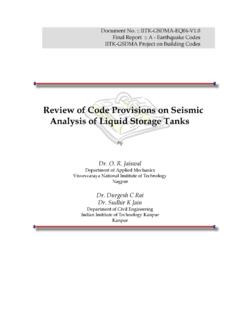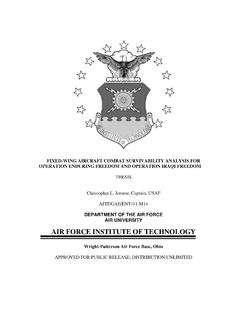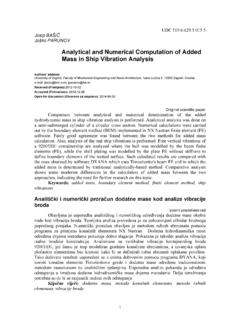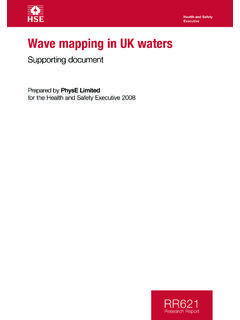Transcription of USE OF 2D MODELS TO CALCULATE FLOOD W …
1 USE OF 2D MODELS TO CALCULATE FLOOD WATER levels : calibration AND sensitivity analysis A. PAQUIER1, E. MIGNOT1 1 Cemagref, Hydrology Hydraulics Research Unit, 3 bis, quai Chauveau, CP220, 69336 Lyon Cedex 09, France, ABSTRACT In case of wide and built-up FLOOD plains, 2D modelling is necessary to obtain a convenient view of the flows during flooding. The complexity of these flows requires possible modelling of supercritical and specific representation of hydraulic structures. Uncertainty of the results remain high because of hazardous events as dike breaching or because of lack of data such as the local rainfall. calibration is usually performed by adjusting calculated peak water levels to FLOOD marks. Information about extent of the flooded area or time of arrival or any other information should also be used to reduce uncertainty.
2 Two FLOOD events, the 1999 FLOOD of the coastal Agly river FLOOD plain and the 1988 FLOOD in the city of N mes are described. On the first event, results of the calibration accuracy are provided in term of average deviation; locally, the difference between calculated peak water level and corresponding FLOOD mark is high because the description of the FLOOD plain does not take into account the buildings in a detailed way and because the influence of infiltration and other secondary processes could not be modelled. On the second example, representing a dense built-up area, a sensitivity analysis was performed in order to identify the parameters that may explain local differences in spite of the representation of the buildings. Higher uncertainty seems to come from the topography including description of the possible storage areas, from flow and rainfall inputs and from specific hazardous events (car blockage or any event due to fixed or mobile obstacle).
3 KEY WORDS: 2D model, shallow water equations, calibration , uncertainty, sensitivity analysis , FLOOD INTRODUCTION Within the framework of the Flooding Risk Program (RIO) supported by the French Ministry of Ecology and Lasting Development (MEDD), Cemagref and his partners are developing tools to estimate the risks of FLOOD in the inhabited areas. These last decades, the urban or suburban development often occurred on the most flat surfaces situated in the plains next to streams. This led to the increase of the number of obstacles opposing to the flow in FLOOD plains such as buildings and embankments. In parallel, the rivers themselves were often channelled and embanked to reduce overflows. Indeed, these works decreased strongly the overflow frequencies, but on the other hand, they let a stronger occupation of the plain develop as people forget the FLOOD risk whereas it remains present.
4 Indeed, floods may still occur, for example if the design discharge is exceeded, or if the main channel capacity is reduced by sediment deposits or vegetation development, or if some dikes break caused by overflows or erosions at the feet of the dike. In order to inform the population and limit this risk by figuring out the best measures or organizations to apply, it is necessary to be aware of the various possible scenarios of FLOOD and to model their consequences (Paquier et Farissier, 1996). The complexity of the flows in the plain during these events requires at least a description of the main obstacles and of the preferential routes of flows. Besides, the possible modification of the directions of the flows during and after the floods makes a 2D modelling more accurate than a one-dimensional modelling based on a network of reaches and storage areas.
5 The values of the parameters to calibrate come at the same time from identified physical processes and from simplifications due to the modelling; furthermore, these simplifications vary in term of places depending both on the stakes and on the precision of the data. The objective is to show how to use a hydrodynamic modelling in this context and especially how to proceed for the calibration . So after a brief description of the software, two large FLOOD events are described: the FLOOD of Agly of November 1999 and the FLOOD of N mes of October 1988, and the bases of the modelling and procedures of calibration are detailed. PRESENTATION OF THE CODE The 2-D computations were performed using the code Rubar 20 developed by Cemagref. It solves 2-D shallow water equations by an explicit finite volume scheme (Paquier, 1998). The cells, triangles or quadrangles, are considered as dry cells as long as the water level is below a minimal value within the cells.
6 A hydraulic structure is defined as a set of a few cells where fluxes through one edge are computed from the relations linking discharge and water levels upstream and downstream. However, as the code can CALCULATE the supercritical flow, some structures may be modelled by their geometry. The numerical scheme is generally stable under the Courant Friedrichs Levy condition that limits the Courant number to values below unity. Rough variations of time steps or of cells dimensions are usually responsible for numerical perturbations, even though in the presented cases, a dimensional ratio of 200 between two adjacent cells did not create major instabilities. The validity of the numerical method was checked on a lot of tests including 1-D and 2-D situations, steady and unsteady flows, cases with or without analytical solutions, comparisons with laboratory experiments.
7 THE 1999 FLOOD OF THE AGLY RIVER The high FLOOD that occurred in the southern part of France in November 1999 after rainfalls between 200 and 400 mm was one of the highest of the 20th century in the lower reach of Agly river. The dam at the higher catchment of the river did not prevent the discharge to reach very high values further downstream where the rainfalls were the strongest. In Rivesaltes (main city at the entrance of the coastal plain), the peak discharge reached about 2000 m3/s which is as high as the historical 1940 FLOOD . Then, as the dikes and the channel widening were designed for a maximal discharge of 1500 m3/s, several overflows occurred which flooded large areas but only with a few centimetres of water. However, one of these overflows was the origin of a breach that suddenly released a 2 meters high wave that destroyed a sewage plant in Saint Laurent de la Salanque, further downstream.
8 In 1996, a 2-D model was built in order to simulate the 100 years FLOOD that could inundate the coastal plain and to define the areas that may be considered as safe enough for extension of villages or of commercial areas. The study (BRL Ing nierie et Cemagref, 1996) calculated the areas flooded after a breaching of the dikes at various locations. Immediately after the 1999 FLOOD , the Authorities gathered observations concerning the event and particularly the higher water level marks. Topographical campaigns permitted to level 43 cross sections of the main channel and the longitudinal profiles of the dikes. In parallel, some urgent works were performed to repair the damage to the dikes and a study was carried out in order to get a diagnosis about the state of the dikes and to define the short term and long term works necessary to increase their safety.
9 It was decided to set a numerical model that would be calibrated from the 1999 FLOOD and that would permit to decide some additional works. To obtain the detailed calibration required, the 1996 model s 2-D grid was densified (the number of cells increased from 8848 to 18568 so the space step was limited to 100 meters) in order to represent the main channel of Agly river in a more detailed way as well as some places in the right bank near the town of Rivesaltes which were flooded in 1999. The structuring lines of the mesh are the major embankments and streams. On the other hand, localized structures such as culverts are modelled by defining the relations linking discharge and water levels upstream and downstream. On the other hand, embankments and weirs on the rivers were described by the topography of ground level and modelled using shallow water equations in which only a Manning coefficient has to be specified and can be estimated by the same method as elsewhere.
10 Although there was a heavy rain over the area of the model, a simplification was to introduce only one discharge hydrograph at the entrance of this area in the Agly main channel. This hydrograph was determined from the measurements of water levels at the hydrometric station of Rivesaltes, and their extrapolations (from the measurements at an upstream station) after the failure of the device. During the calibration , it was checked that the water levels computed at that point were in agreement with the measured and then extrapolated ones. The Manning friction coefficient values in the FLOOD plain generally do not influence the results too much as the flows depend mainly on the discharges over the dikes and through the embankments. The calibration of the friction coefficients is more difficult in the main channel of the river, especially because of two uncertainties: the discharge entering the embanked channel is not exactly known ( 10 to 20 %) and the topography of the main channel at the time of the peak flow was different from the results of the topographic survey a few weeks after the FLOOD because of deposits.






